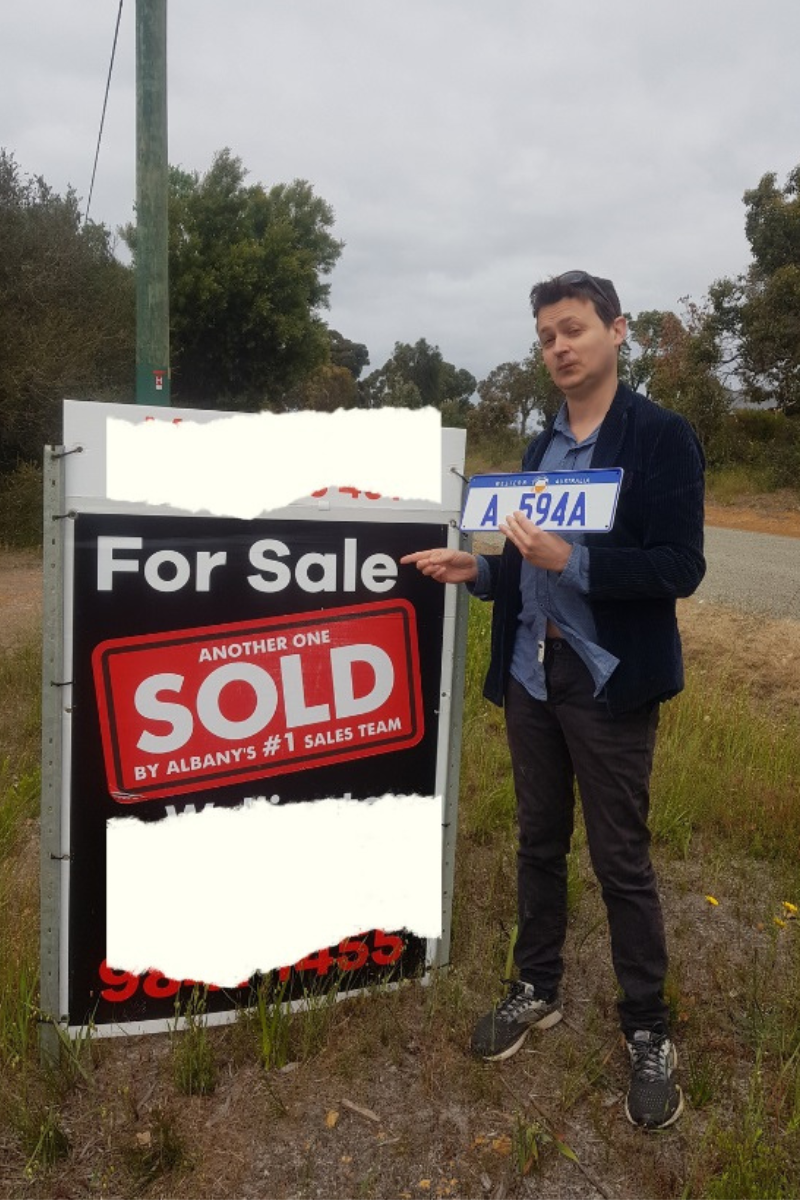
(This is the look of a man who no longer has to rent an asbestos shithole. Many Albany residents aren't so lucky. Much system change needed!)
Asbestos has a dramatic history in Western Australia. So much so that the town of Wittenoom is the site of one of the world’s worst industrial disasters where 2000 people have lost their lives to date. It remains to this day the largest contamination site in the southern hemisphere. This tragedy is covered in the famous Midnight Oil song ‘Blue Sky Mine.’ At least 4000 Australians continue to lose their lives every year from asbestos related diseases.
One would hope that our society might be together enough to learn from the tragedies of the past. In WA, our collective psyche seems to believe that asbestos was a disaster from another era and that we have moved on. Instead, we seem to be sweeping our past under the rug, out of sight out of mind. I mean this both figuratively and literally.
Several years ago, I was shocked to discover that, far from being a thing of the past, many new developments in our major cities are inadvertently being built with materials containing asbestos, often made in China and slipped under the radar of our deregulated building codes. The Perth children’s hospital development was an infamous example. Since moving to WA, asbestos has followed me around like a persistent ghost. At every point, my attempt to address this issue has encountered ineptitude, apathy and downright hostility from our broken and deteriorating social systems.
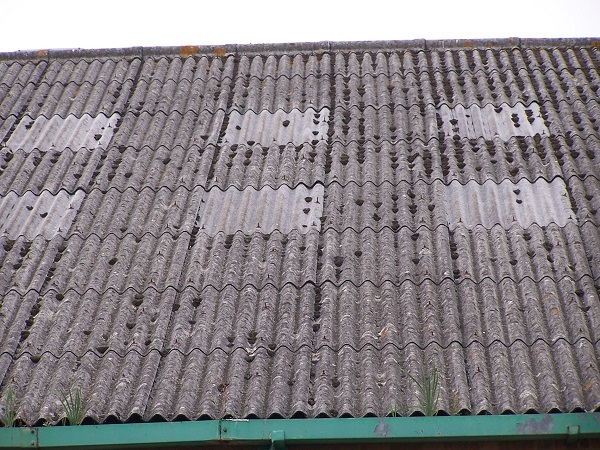
(What do you mean this aint pretty? WA was BUILT on this stuff. So what if it is an eyesore. Or a lungsore...photo courtesy of Shutterstock).
Below is an account of my past year dealing with asbestos in Albany, Western Australia. It is actually hilarious in a grim, Kafkaesque kind of way. Enjoy the ride!
It began in September 2021 when I moved quickly from Adelaide to Albany in a narrow gap between lockdowns and had to find a rental as quickly as possible. Bracing myself, I did a tour of the local real estate offices where they took great joy in telling me that "Albany is up-and-coming. That there is UNPRECEDENTED demand and little supply and that there may be a couple of places available BUT it won’t be easy and it won’t be cheap!" They love it, don’t they?
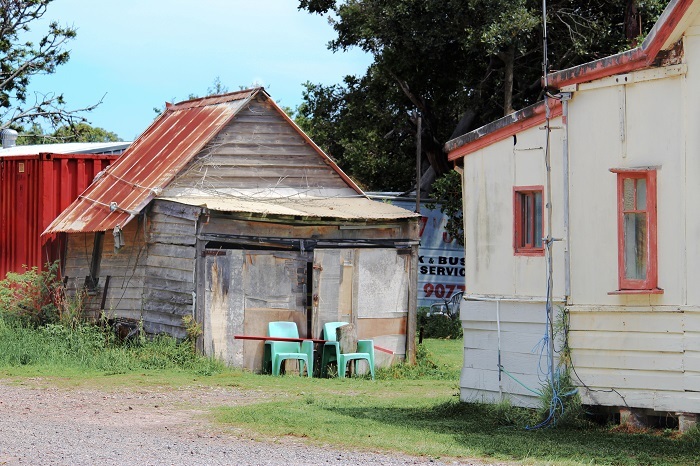
(You say dilapidation? I say INVESTMENT. There's a wait list for beauties like this in Albany. Photo courtesy of Shutterstock).
There happened to be a fibro box with a garden within walking distance from town going for $310 a week, which apparently was good value in this saturated market (consider the fact that the national housing market is so broken that even a regional town 5 hours south of the most isolated capital city in the world is still unaffordable). It obviously needed re-stumping as the bedroom wall was dropping and the floor was sloping so much in the front room there was a danger that I could roll out of bed. But it would have to do. So, I filled out a number of forms and in amongst it all there was a discrete, unassuming disclosure form which acknowledged that it was an asbestos structure. I knew that both the outside and inside asbestos walls were painted so I didn’t make much of it, so I moved in and dealt with all of the challenges of living in a house that had for the most part, been allowed to run itself down for many years.
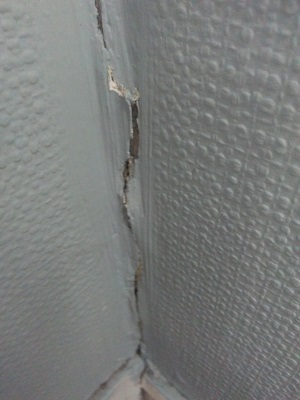
('Might need a restumping'. My rental was at such an angle that the walls were shearing apart. My property 'manager' was more interested in me keeping the grass cut. Priorities y'know.)
So, I was very happy when just before Christmas 2021, I was involved in the private purchase of a unit in Albany. This came as a huge relief as it finally enabled me to step away from Australia’s insidious rental industry. Finally, there was an opportunity to spend my hard-earned money in order to help build a place up, as opposed to parting with my money in order to finance a landlord’s mortgage (who in too many cases has little interest in maintaining it beyond the most basic levels of liveability).
Of course, bringing the unit - built in 1978- into the 21st Century, involved auditing the property for any asbestos that may have been used in its construction. _Asbestos was not phased out from housing construction in Australia until 1990. _
The first project was to remove an old asbestos shed that was attached to the side of the property. The second was to paint the decades old asbestos fences within close proximity to the property. It was too expensive in this instance to have the fences replaced, especially as it involved getting multiple neighbours involved. In order to audit a property, you need to know what you are looking for and it was while doing this research that I stumbled upon two little known facts. One is that old vinyl sheet flooring often has a backing that consists of 100 percent compressed asbestos fibres and that if disturbed, they can become instantly friable. At the same time, I discovered that asbestos was often added to the putty around windows.
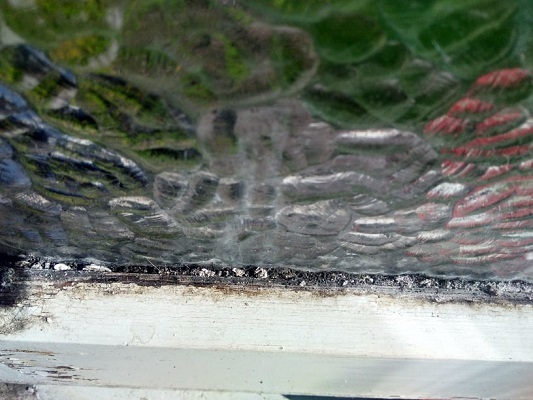
(like this one!)
What is friable asbestos I hear you ask? It is that which can be crumbled, pulverised or reduced to a powder by hand pressure. Much easier to get into air passages and wreak havoc, in other words.
While this wasn’t an issue in the house that I was involved in renovating, this research led me to discover (to my horror) that the house that I was renting, had an old ripped vinyl sheet floor with mysterious white powder oozing out of it in the bedroom. In addition, there was crumbling putty around the windows in multiple rooms that was leaving a fine greyish powder on the window ledges and floor. This sent alarm bells ringing, especially as I had been sweeping and vacuuming these powdery substances up for some months.
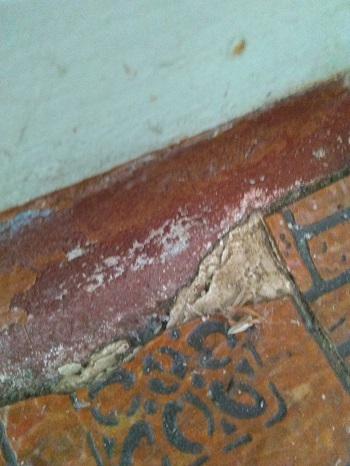
(Yes, the floor titles had seen better days).
Naturally my first reaction was to curse to high heaven. My second reaction was to take stock of circumstances. So, I wrote a fairly detailed email to the Property Manager outlining the issues and suggested that samples be taken from the vinyl in the front room as well as the crumbling putty in the windows. I stated that -
“If they both come out negative for asbestos, I will happily pay the remaining rent until the end of the lease and also pay to have the house cleaned. But obviously if you refuse to do the testing, I shouldn’t be expected to pay any more rent as it wouldn’t feel safe to return without a negative result.”
Up to this stage this issue had not been personal, it had been an obvious failure of the system, but the response from my property manager felt both brutal and personal. Not only was my request for testing ignored, she referred me to the asbestos disclosure that I had signed at the start of the lease. At the time of signing, I assumed that this disclosure was in reference to the landlord or agent not being liable if I (for example) drilled into the asbestos walls. I did not expect it to be used as an excuse to ignore the presence of potentially friable asbestos prior to the lease being signed. In other words, it could be used to override a landlord’s duty of care.
The property manager did agree to end the lease three weeks early but demanded that I continue to pay rent for the following two weeks without any testing being undertaken. So, I had to endure the double whammy of not knowing whether I had been exposed to asbestos while also being forced to pay a further 620 dollars in rent on a house that I no longer felt safe to live in.
So, I decided to seek legal advice. Surely, I thought, given the persisting legacy of asbestos in WA and given that this stuff, you know – kills, that the system would be perfectly geared to providing the advice that I needed quickly. How naïve was I? But seriously folks, there is where it gets ridiculous.
Tenancy WA referred me to a third-party legal advice organisation. In order to get someone to phone me, I had to fill out many forms, pay $40 and wait a whole week for the phone call, as they rescheduled and protracted. I was provided some very broad advice around needing to leave the house immediately (which by then I already had done), and some legal clauses that I could use as a tenant (which didn’t work in the end). The lawyer on the phone was not allowed to put anything into writing, which meant that I had to memorise a lot of complex legal jargon from a single phone call. Nor was I allowed to send through any draft correspondence that I was writing to the real estate agent in order to get advice on whether I was framing things correctly. Hence, it was a lot of busywork to get nowhere slowly, with the onus of responsibility thrust back onto yours truly.
I also contacted a community legal aid centre in Albany who would only accept my application AFTER I had had the discussion with Tenancy WA and after I summarised the conversation for them in writing. I also had to fill in a bunch of paperwork and documents for them. It then it took another month before I finally received one phone call from them. This was due to multiple factors, including the ONE tenancy lawyer being off sick with COVID, or unexpected emergencies in the office. Their automated appointment system was also inaccurate, giving me wrong dates and times, which meant that I had to call reception on many occasions to problem solve the issues with them. By the time they finally contacted me, it was well and truly after the fact.
In the meantime, I had vacated myself and my possessions out of the house. Because no testing had been done, I had no choice but to take the mattress that had been exposed to powder from the floor and the windows to the tip. I just couldn’t risk keeping it. Fortunately, I have an uncle with a holiday house in the Perth Hills which was vacant and where he said that I could stay for as long as necessary. Unfortunately, it was a five hour drive up the road. For all my displacement, I was thankful to have a stable job that allowed me to work from home (wherever home happened to be that month). It became apparent at that stage that I wouldn’t get any legal support any time soon so I begrudgingly paid the remaining two weeks rent, knowing that if I didn’t, I would lose my bond. But I couldn’t live with the uncertainty of whether or not I had been exposed to asbestos, so I ended up forking out to pay for the tests myself. So not only had I had to pay rent on a house that I did not feel safe living in, I also had to pay for the testing too.
Upon arriving at my uncles, I dared a deep sigh of relief that I was away from potential danger. Ironically as I drew in a nice big breath, I noticed bits of broken asbestos fencing scattered around his garden, some of which was mixed in with the gravel pathways where people regularly walk. So, I stopped breathing so freely as I embarked on a project to clean this up and have it taken away. I also noticed piles of it dumped in the adjoining bushland, which is something that I will have to tackle at a future date. This was in all likelihood a legacy from an asbestos house that was demolished on the site back in 1992. It seemed that there was no escaping from it.
In the meantime, I continued to call around for advice. Albany Council said that they ‘couldn’t intervene in real estate/tenancy relationships’ and my contact at Worksafe was reluctant to review a draft email that I had prepared in response to the real estate agent. The most absurd conversation was with the asbestos expert for a State health department. When I suggested to him that Real Estate organisations need to take a more proactive approach towards asbestos management, his response was ‘we live in a prosperous and affluent state and we can’t get in the way of business by forcing more legislation onto real estate agents.’ I couldn’t believe my ears.
There is a positive outcome to this story, at least for me. The asbestos results actually came back negative, much to the surprise of the asbestos professional who thought that at the very least, the vinyl floor sample would come back positive. On the same day he had tested another very similar vinyl floor in another house that turned out to be positive. It was the luck of the draw. He did say that I did the right thing by leaving the house immediately as it was the safe thing to do. Also, the real estate agent did return most of the bond in the end – although all of this amount and much more was consumed by the asbestos test fees, short term accommodation fees, the cost of relocation, driving to Perth, a new mattress and having to pay two weeks rent on an empty house.
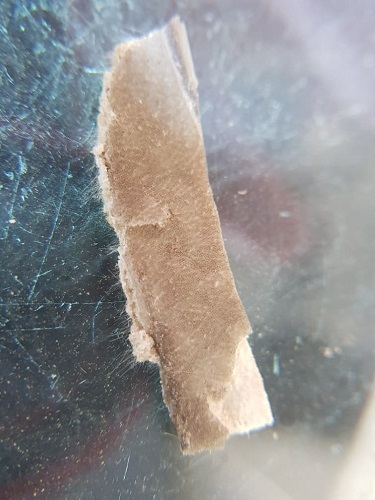
(The sample taken of the vinyl sheet flooring under the microscope showed to my relief that the white fibres were synthetic and not asbestos.)
I was so relieved with the outcome, if only for the fact that it took every ounce of my energy and capacity just to reach this point. Had results come back positive, the ensuing battle with the estate agent risked being long, protracted and nasty. I knew this because the asbestos professional who did the testing informed me that tenants have in the past spent years and in one case at least, tens of thousands of thousand dollars (as well as having to teach themselves law) in order to win cases against landlords.
Sadly, there is no solace to be found in the hope that the risk of exposure to asbestos in WA will recede any time soon. It is probable that Albany won’t even have the luxury of professionals who test for and remove asbestos in the medium-term future. Paying for someone to come down from Perth will be expensive, so many people won’t do it. Instead, they will take risks and cut corners. This is because the WA government is passing laws that make it even more costly to remove asbestos legally. When I had the small asbestos shed removed it cost two and a half thousand dollars. If I were doing that today it would likely cost three and half thousand.
Government agencies justify this because it is costing them a lot of money to remove illegally dumped asbestos in public areas. Of course people are in part illegally dumping asbestos because they don’t want to pay to do it properly. So, the state government have dim wittingly dug themselves into a positive feedback loop. This however is no excuse. The illegal dumping of asbestos is a serious offence and it should receive serious penalties. Nevertheless, we can only expect illegal asbestos dumping to get worse as costs become more prohibitive.
Of course, this is also indicative of a larger scale issue whereby too much power has been siphoned towards landlords and real estate companies, who get to write their own rules, are not held to account and are generally regarded as being too big to topple. I was lucky in the sense that I got to escape from the insidious rental ‘market’. Many others are not as fortunate as myself and are locked in for life. If the only place that becomes available is an asbestos shit hole, then it seems that you have to fork out the money and be “grateful”. If that means that you get mesothelioma or lung cancer or asbestosis, then it is clear that neither Albany’s largest real estate agent, nor the state government, care if you die.
If you still think that society is capable of learning from its past mistakes, I have one more shock for you. The dust from cutting manufactured stone, which is the standard for most kitchens in new homes, exposes workers to the risk of silicosis and this is a growing epidemic that is cutting the lives short of up to one in three people who work with manufactured stone. I have tried to promote a safe and ecological alternative to manufactured stone made out of recycled glass bottles to builders but this has fallen mostly on deaf ears. So, the cycle continues…
Ultimately, this article is not to incite despair and indifference, but rather to incite change. We need to make this into a political issue, especially as it feeds into a wide range of other issues around our dire housing situation. Too many have died. Too many more will die.
Given that both major parties have made careers out of sticking their heads in the sand, it is worth considering voting for a viable minor party. Don’t give (un)Real Estate Agents any more oxygen than is necessary for your survival. If you own your home or are renovating, please choose an alternative to stone kitchen bench tops. Also, If you get the opportunity to get asbestos professionally removed, please do, as you are doing the whole community a service. We want to phase out what is behind an enduring systemic industrial cancer inducing disaster.
As a footnote, I am currently building a house in outer Albany and have had to deal with exposed asbestos piping on-site on two occasions (and counting). This is a reminder that we have a long way to go before WA can truly put to rest the ghosts of Wittenoom.

(Asbestos: the gift that keeps giving)
I will be co-writing a sequel to this article with Mark Allen from Town Planning Rebellion which will be looking at the policy directions that we should be taking in terms of handling our asbestos legacy as the rental crisis continues to bite. Also, how does this fit in with the wider approach that we need to be taking towards sustainable planning in WA?
